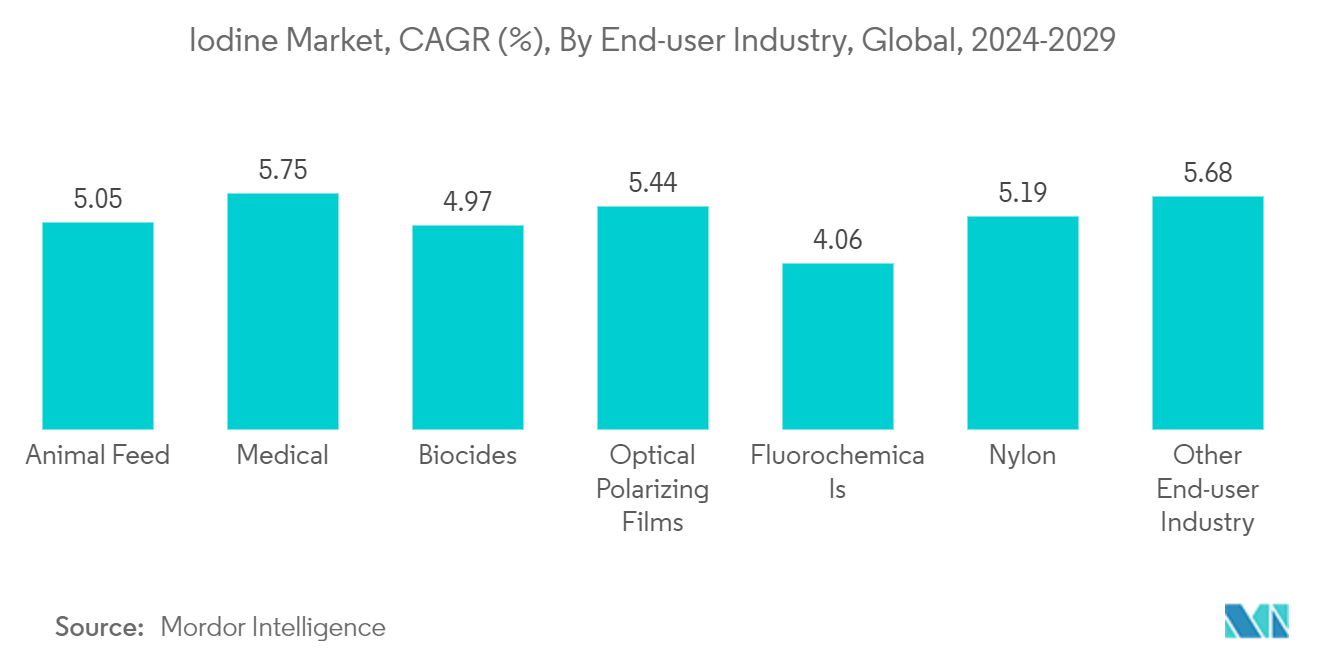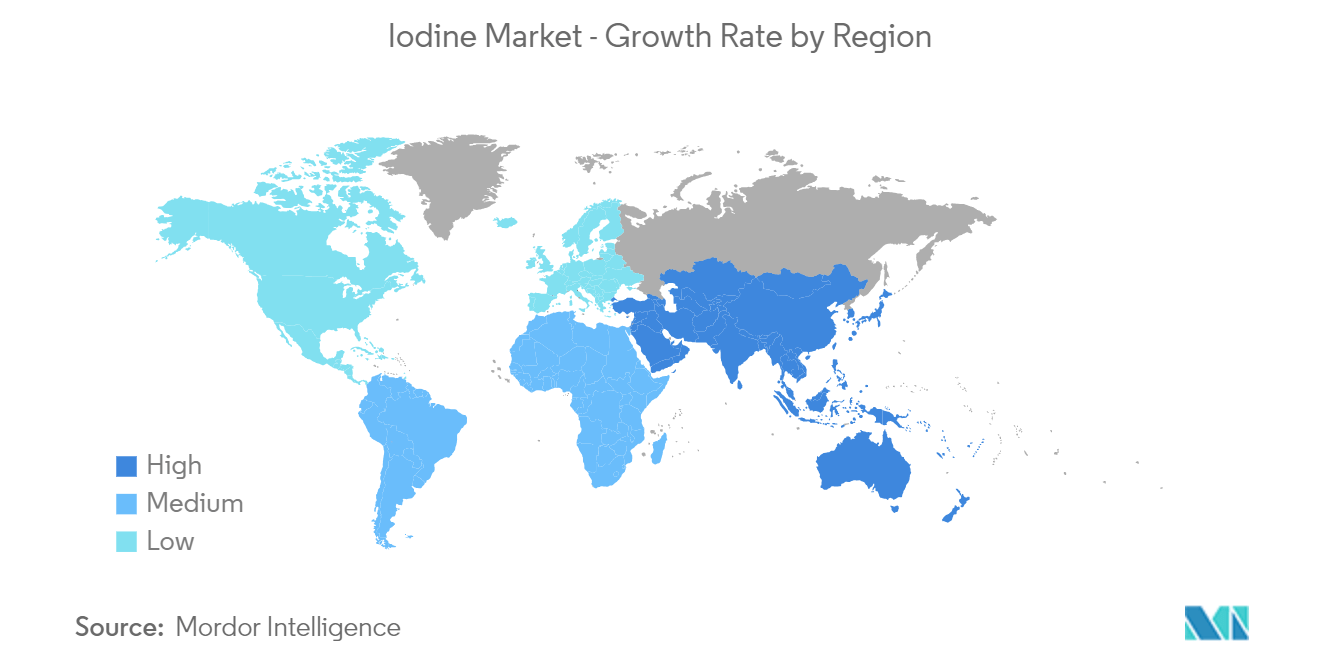Market Trends of Iodine Industry
The Medical Segment is Expected to Dominate the Market
- Iodine is a crucial element in the medical industry, with many applications in diagnosis and treatment. Its most common use is in producing antiseptics and disinfectants, where iodine's ability to kill bacteria, viruses, and fungi makes it an effective tool for preventing infections.
- In addition, iodine is used to produce radiocontrast materials, which are used in medical imaging procedures such as CT scans, X-rays, and angiograms. These materials contain iodine atoms, which absorb X-rays and make the internal structures of the body visible in the resulting images.
- The demand for iodine has been increasing over the rising need for X-ray contrast media because of its high atomic number, low toxicity, and ease of adjunction with organic compounds.
- Iodine is a simple, effective, and cost-efficient means of water disinfection for people who travel or work in areas where municipal water treatment is unreliable. In terms of the disinfection of drinking water, iodine is commonly used in the form of tablets or solutions during emergencies and by travelers. As the number of travelers has increased in recent years, the demand for iodine as a disinfectant has also been increasing.
- In January 2024, according to the University of Maryland School of Medicine, a large multicenter clinical trial co-led by the University of Maryland School of Medicine researchers found that an antiseptic containing iodine (iodine povacrylex in alcohol) resulted in about one-quarter fewer post-surgical infections in patients with limb fractures compared to another frequently used skin antiseptic.
- In January 2024, China National Nuclear Corporation (CNNC) started the construction of a powerful solution-type medical isotope test reactor. This initiative will produce Iodine-131 and iodine-125, among other medical isotopes. Medical isotopes are typical radioactive isotopes that are used for medical purposes. For example, iodine-131 is used for radiotherapy or imaging. It can also be used to destroy dysfunctional thyroid tissues and many other medical applications. According to CNNC, after completing the medical isotope reactor, which is estimated to be completed by 2027, it will attain an annual production capacity of 20,000 curies of iodine-131, surpassing the current domestic demand.
- According to AstraZeneca, the projected pharmaceutical sales in 2024 are expected to be USD 633 billion for North America, holding the major share, followed by the European Union (excluding the United Kingdom) with USD 287 billion at the second position, followed by Southeast and East Asia and expected to register USD 232 billion. Also, the total spending on medicines in 2020 was USD 1,265.2 billion, which is expected to generate a revenue of USD 1,595 billion in 2025.
- Hence, owing to the above-mentioned factors, the medical end-user industry is expected to dominate the market for iodine from 2024 to 2029.

Europe is Expected to Dominate the Market
- Europe is expected to dominate the iodine market between 2024 and 2029. Countries like Germany, the United Kingdom, and Italy are seeing rising demand for iodine in animal feed, medical, and biocide applications.
- According to the German Animal Feed Association (DVT), at 21.7 million metric tons (mmt), feed production in Germany in the 2023 calendar year was around 360,000 metric tons (mt), or 1.6% less than in the previous 12 months. The DVT President announced that the year-on-year contraction represents a partial easing in the long-term contraction in the German feed sector. The decline in total national feed output is attributed mainly to reduced sales of pig feeds. This segment’s production was down approximately 500,000 mt or 5.8% to 8 mmt for 2023.
- Moreover, Germany has the highest wastewater reprocessing and recycling rate in Europe. More than 96% of the wastewater from private households or public facilities is discharged into nearby sewage treatment plants for processing. With the country’s increasing sewage water volume, these plants are expected to exploit a larger volume of iodine-based biocides between 2024 and 2029.
- The medical industry is the largest consumer of iodine. According to data from the Association of the British Pharmaceutical Industry released in December 2023, businesses in the UK life sciences industry generated EUR 108.1 billion (USD 115.4 billion) in turnover in 2022, a 13% increase from the EUR 95.9 billion (USD 102.37 billion) turnover in 2022. Turnover has seen an upward trend since 2013 but increased sharply between 2021 and 2022. The sector that generated the highest turnover was the biopharmaceutical core sector, accounting for 43% of the total turnover generated across the life sciences industry. This was followed by the biopharmaceutical service and supply and medical technology core sectors, each accounting for 25% of turnover in 2022. Such trends affect the consumption of iodine.
- The Italian pharmaceutical industry represents a vast and reliable manufacturing base with a dedicated workforce of around 67,000 people. It is technologically advanced and has a strong leadership position in Europe and beyond.
- According to the data from the Farmindustria-Prometeia 2023 survey, the Italian pharmaceutical industry is the driving force of the country's economy. In 2023, the industry value reached EUR 50 billion (USD 55.3 billion). The Italian pharmaceutical production plays a vital role in Europe’s pharmaceutical industry. The sector’s output increased by 7.3% in 2023 compared to 2022, according to the Farmindustria-Prometeia 2023 survey.
- Owing to the factors mentioned above, the market for iodine in Europe is projected to grow significantly between 2024 and 2029.


